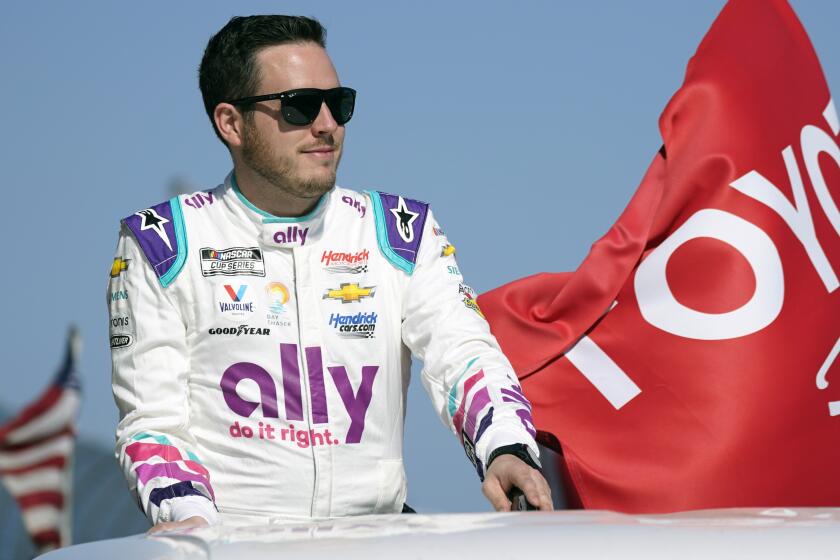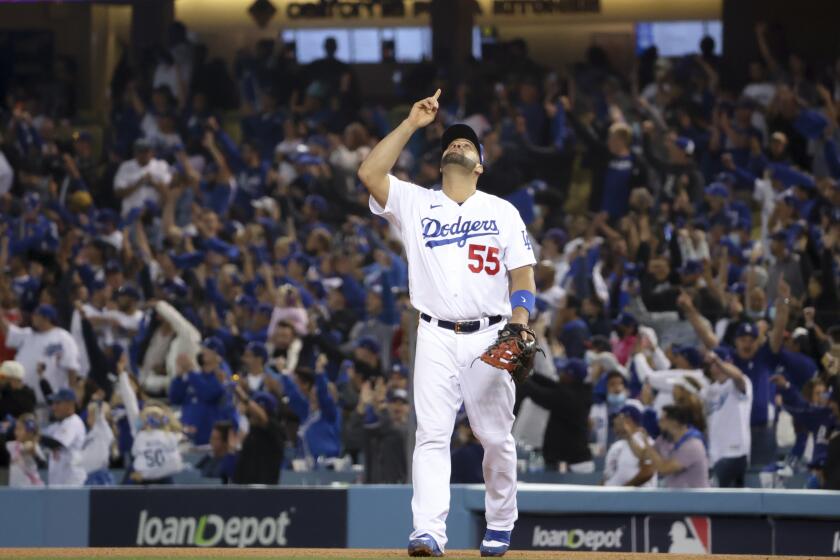Fontana’s well-worn track welcomes back NASCAR before a makeover likely to add drama

- Share via
A celebration certainly, a sendoff perhaps, the WISE Power 400 at Auto Club Speedway in Fontana on Sunday will combine elements of a storied past, a dynamic future and a keep-your-eyes-glued-to-the-road focus on the present.
It will be the silver anniversary of the venue originally dubbed the California Speedway, built on the site of a steel mill hard by Interstates 10 and 15. The 25 years were marked by three stretches of dominance, with Jeff Gordon winning the first NASCAR race at the speedway in 1997 and three of the first eight, Jimmie Johnson winning six times in 15 years beginning in 2001 and Kyle Busch winning four times recently, including in 2019.
It also might be the last time a NASCAR race is held on the two-mile track. Plans to shorten it to a half-mile were submitted to San Bernardino County in September 2020 with the expectation that the first race on the short track would take place in 2023. But the process was slowed by COVID, giving the NASCAR innovation and development teams more time to brainstorm, so any thoughts of billing Sunday’s race as a last hurrah for the two-mile oval were given the caution flag.
And it will be another test for the new Next Gen racecars that debuted three weeks ago at slow speeds and hard contact on a quarter-mile track at the Coliseum and were saddled with restrictor plates one week ago at the Daytona 500. Drivers feel like this will be the first time the cars can let loose on one of the fastest tracks on the NASCAR circuit.
“It’s a driver’s track, and it’s aged over time,” Busch said. “You can run all over it. . . . I hope the Next Gen car will also allow us to move around and be pretty racy.”
Alex Bowman won the last NASCAR Cup race in Fontana two years ago. He’s looking to repeat, but Kyle Busch and Kyle Larson will be ones to watch, too.
Truth be told, the track is so abrasive and bumpy that its condition triggered the plan to shorten the track. Why redo the asphalt when the entire track could be replaced? And with NASCAR listening to its fans and making a calculated move toward shorter tracks, whittling down the length by three-quarters was deemed the way to go.
“It’s obviously a fun racetrack for the drivers to go to because of the surface,” said Kevin Harvick, who holds the track record with a qualifying lap at 188.7 mph in 2016. “But in reality, the surface is getting close to the end of its life.
“And I think as we ran this new car at the Coliseum and the success of the event and the ways the cars were able to race and the excitement it generated, it’s hard to vote against short-track racing.”
Fans have clamored for more short-track races for years, citing their better views of the track and the increased drama of cars bumping and jostling to pass. Tempers flare, wrecks are frequent but usually not horrific because of the slower speeds and everyone gets nostalgic for the tiny, dusty tracks drivers cut their teeth on as teenagers.
NASCAR was slow to warm up to the notion. Currently only three tracks of the 26 on the circuit are less than one mile — Richmond Raceway, Martinsville Speedway and the dirt race at Bristol Motor Speedway.
But forward-thinking officials, chief among them 30-year-old Ben Kennedy, NASCAR’s senior vice president of strategy and innovation, now consider short tracks a key component in the sport’s future. Transforming the Coliseum into a rowdy quarter-mile event with seven qualifying races ahead of the main event was only step one in a plan to bring racing to new fanbases in large cities all over the world.

“I think one of the neat things about our sport is that we have everything from a short track, intermediate track, road courses and super speedways,” Kennedy said. “It emphasizes that these are the best drivers in the world, and they compete on all these different types of tracks. In order to be a champion, you have to compete and win on all of them.”
Downsizing racetracks won’t become all the rage precisely because they trigger too much rage.
“I think short-track racing is awesome, it’s really the grassroots of our sport,” said Austin Cindric, who didn’t qualify for the main event at the Clash because of a crash but won the Daytona 500 two weeks later. “But as far as doing a bunch of races like that on our schedule, no.
“I probably had the worst experience [at the Clash] in terms of the amount of carnage and aggression in such a confined space. It’s like trapping a bunch of lions inside a boxing ring. It was controlled chaos, without a doubt.”
Soon the Auto Club Speedway could become the go-to venue for that level of intense racing on an annual basis. And it won’t resemble an old-time country fair short-track bullring. Far from it.
Albert Pujols will serve as honorary pace car driver and Andrew Whitworth will be grand marshal for the NASCAR Cup Series race at Auto Club Speedway.
“I’ve seen renderings of what the Next Gen Auto Club Speedway will look like,” said NASCAR official Matt Humphrey. “It’s a state of the art racing facility like nothing else we have on the circuit. It will be revolutionary in its design and function.”
Dave Allen, longtime president of the speedway, is charged this week with tempering enthusiasm for the new track because it doesn’t yet have final approval. His focus is on attracting fans Sunday who enjoyed the Clash at the Coliseum and want more NASCAR regardless of track length.
“We hope to draw from all over,” Allen said. “Clash allowed us a platform to promote the sport in L.A. There’s nothing like taking the race to the fans. We may not see an immediate huge impact Sunday, but the larger impact is a long-term play. It opened eyes.”
NASCAR might never draw the Hollywood crowd, but the Auto Club Speedway does. Numerous movies, television shows and commercials have been shot there over the years. Morgan Freeman in a 1965 Shelby Mustang GT350 raced Jack Nicholson in a 1970 Dodge Challenger in “The Bucket List.” So did Matt Damon and Christian Bale in “Ford v. Ferrari.”
Allen said the short track — when approved and built — won’t deter film crews from continuing to utilize the speedway. Up first, though, a race with new cars on an old track will provide real-life competition.
More to Read
Go beyond the scoreboard
Get the latest on L.A.'s teams in the daily Sports Report newsletter.
You may occasionally receive promotional content from the Los Angeles Times.













